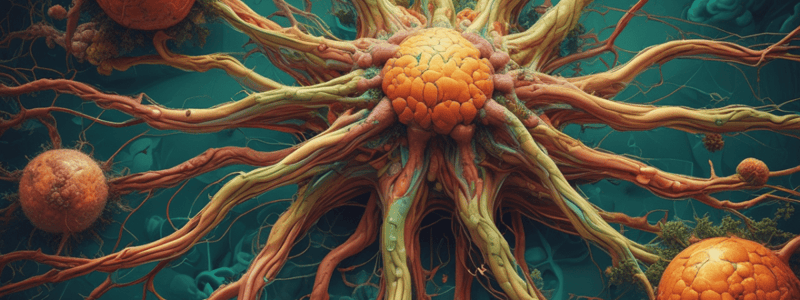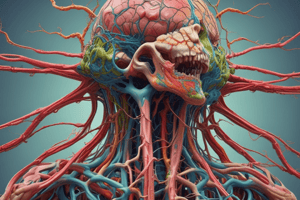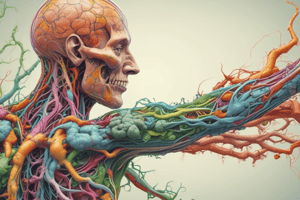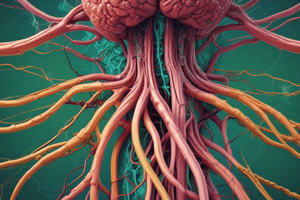Podcast
Questions and Answers
Which component of the lymphatic system is responsible for the development of the critical immune response?
Which component of the lymphatic system is responsible for the development of the critical immune response?
- Lymphocytes
- Lymph fluid
- Lymph vessels
- Lymph nodes (correct)
What is the primary function of the lymphatic system in relation to the circulatory system?
What is the primary function of the lymphatic system in relation to the circulatory system?
- To filter pathogens from the blood
- To provide a route for the circulation of lymphocytes
- To transport dietary lipids and fat-soluble vitamins
- To bring excess fluid from the interstitial spaces to the bloodstream (correct)
What is the role of lymphocytes in the adaptive immune response?
What is the role of lymphocytes in the adaptive immune response?
- Lymphocytes produce plasma cells that bind to specific molecules known as antigens
- Lymphocytes help mediate the immune response against parasites and pathogens
- Lymphocytes are phagocytic and ingest pathogens
- Lymphocytes coordinate the adaptive immune response (correct)
Which of the following is NOT a characteristic of the lymphatic system?
Which of the following is NOT a characteristic of the lymphatic system?
What is the primary function of the innate immune response?
What is the primary function of the innate immune response?
Where do all leukocytes (white blood cells) originate?
Where do all leukocytes (white blood cells) originate?
What is the primary function of the lymph nodes?
What is the primary function of the lymph nodes?
What is the role of the spleen in the immune system?
What is the role of the spleen in the immune system?
What is the function of the tonsils in the immune system?
What is the function of the tonsils in the immune system?
What is the main difference between lymph nodes and lymphoid nodules?
What is the main difference between lymph nodes and lymphoid nodules?
What is the purpose of the mucosa-associated lymphoid tissue (MALT)?
What is the purpose of the mucosa-associated lymphoid tissue (MALT)?
What is the primary function of the efferent lymphatic vessels in a lymph node?
What is the primary function of the efferent lymphatic vessels in a lymph node?
What is the primary reason why a vaccine for HIV/AIDS has not been developed after 30 years?
What is the primary reason why a vaccine for HIV/AIDS has not been developed after 30 years?
Which type of hypersensitivity reaction is characterized by the accumulation of antigen-antibody complexes along blood vessel linings, causing inflammation?
Which type of hypersensitivity reaction is characterized by the accumulation of antigen-antibody complexes along blood vessel linings, causing inflammation?
What is the primary reason why autoimmune diseases are more rare in countries with high infectious disease rates?
What is the primary reason why autoimmune diseases are more rare in countries with high infectious disease rates?
What is the primary reason why a healthy immune system can control some cancers?
What is the primary reason why a healthy immune system can control some cancers?
What is the primary reason why organ transplant recipients must match MHC alleles, and not just blood type?
What is the primary reason why organ transplant recipients must match MHC alleles, and not just blood type?
What is the primary reason why the immune system can cause complications in cancer treatment, but the benefits still outweigh the risks?
What is the primary reason why the immune system can cause complications in cancer treatment, but the benefits still outweigh the risks?
What is the main function of Helper T cells in the immune response?
What is the main function of Helper T cells in the immune response?
In the process of T cell tolerance, what happens during positive selection?
In the process of T cell tolerance, what happens during positive selection?
Which type of T cell is responsible for killing target cells by inducing apoptosis?
Which type of T cell is responsible for killing target cells by inducing apoptosis?
What is the main role of B cells in the immune system?
What is the main role of B cells in the immune system?
Which antibody class is associated with allergies and anaphylaxis?
Which antibody class is associated with allergies and anaphylaxis?
What is the immediate response time for a secondary exposure compared to the initial response?
What is the immediate response time for a secondary exposure compared to the initial response?
Which immune response involves coating a pathogen to make it impossible to bind to a receptor?
Which immune response involves coating a pathogen to make it impossible to bind to a receptor?
What is the main difference between Central Tolerance and Peripheral Tolerance in B cells?
What is the main difference between Central Tolerance and Peripheral Tolerance in B cells?
"Clonal selection" refers to which process in the immune response?
"Clonal selection" refers to which process in the immune response?
"Memory B cells" react similar to which other type of immune cell?
"Memory B cells" react similar to which other type of immune cell?
Which of the following is NOT a function of BALT (bronchus-associated lymphoid tissue)?
Which of the following is NOT a function of BALT (bronchus-associated lymphoid tissue)?
Which of the following statements about the innate immune response is FALSE?
Which of the following statements about the innate immune response is FALSE?
Which of the following cells is NOT involved in the innate immune response?
Which of the following cells is NOT involved in the innate immune response?
Which of the following is a function of the complement system?
Which of the following is a function of the complement system?
Which of the following is NOT a characteristic of the adaptive immune response?
Which of the following is NOT a characteristic of the adaptive immune response?
Which of the following molecules is involved in the inflammatory response?
Which of the following molecules is involved in the inflammatory response?
Which of the following is a function of T cells in the adaptive immune response?
Which of the following is a function of T cells in the adaptive immune response?
Which of the following statements about MHC molecules is TRUE?
Which of the following statements about MHC molecules is TRUE?
Which of the following statements about autoimmune diseases is FALSE?
Which of the following statements about autoimmune diseases is FALSE?
Which of the following is NOT a function of cytokines in the immune response?
Which of the following is NOT a function of cytokines in the immune response?
Study Notes
Anatomy of the Lymphatic and Immune Systems
- Immune system: cells and organs that destroy pathogens
- Lymphatic system: vessels, cells, and organs that bring excess fluid to the bloodstream and filter pathogens from the blood
- Lymph: interstitial fluid in the lymphatic system
- Dietary lipids and fat-soluble vitamins are absorbed and travel in lymphatic vessels to the liver
- Lymph node: major staging area for development of critical immune response
Structure of the Lymphatic System
- Open-ended capillaries that feed into larger vessels and eventually into the subclavian vein
- Capillaries are simple squamous endothelial cells
- We have 500-600 lymph nodes along those vessels
- Lymph is not pumped – it moves by breathing, muscle contraction, and body movements
- One-way valves keep it moving toward the heart (like veins)
- Areas with no lymph vessels: bone marrow, CNS, teeth, and cornea
Organization of Immune Function
- Barrier defenses: skin and mucous membranes, prevent invasion
- Innate immune response: rapid, but non-specific cells
- Adaptive immune response: slower response of lymphocytes
- All leukocytes come from the red marrow (myeloid or lymphoid)
- Phagocytic cells: ingest pathogens
- Lymphocytes: coordinate adaptive immunity
- Granular cells: help mediate immune response against parasites and pathogens like bacteria and viruses
Barrier Defenses and Innate Immune Response
- Barrier defenses: most basic, continuously working (skin and sweat, mouth, stomach, mucosal surfaces, and normal flora)
- Innate immune response: rapid, non-specific, not always effective
- Adaptive immune response: slower to develop, highly specific, very effective at attacking a wide variety of pathogens
Innate Immune Cells
- Macrophage: phagocyte that will roam or take a fixed position, first line of defense, cooperates with lymphocytes
- Neutrophils: phagocyte that is attracted via chemotaxis, reinforcements, cooperate with lymphocytes
- Monocyte: differentiates into a macrophage or dendritic cell
- Natural killer cells: induce apoptosis in an infected cell by releasing the fas ligand to bind to the fas molecule on the infected cell or by releasing perforins and granzymes
Antigen Presentation and Recognition
- Antigen-presenting cells: present antigens to T cells
- T cells: recognize antigens on the surface of an antigen-presenting cell
- Major histocompatibility complex (MHC) molecules: present antigens on the surface of cells
- Antigen processing: breaking down antigens into smaller pieces for presentation
T Cell-Mediated Immune Responses
- T cells: coordinate adaptive immune response
- Antigen recognition: T cells recognize antigens on the surface of antigen-presenting cells
- Variable region: specific for binding to a single particular antigen
- Antigens: the region on a pathogen that binds to a receptor
- Carb antigen: bacteria and RBC
- Protein antigen: viruses and worm parasites
Adaptive Immune Response
- Primary adaptive response: first infection has worse symptoms because adaptive immune system needs to become effective
- Secondary adaptive response: next infection is most likely eliminated before you notice a symptom, this is immunological memory
- Autoimmune disease: adaptive immune response begins to attack your “self” cells
Lymphoid Organs
- Lymph nodes: remove debris and pathogens, dendritic cells and macrophages kill many pathogens, many B and T cells are present
- Spleen: extensive vascularization, known as “filter of the Blood”, holds many dendrites and macrophages
- Lymphoid nodules: dense cluster of lymphocytes without a fibrous capsule, found in respiratory and digestive tracts (tonsils)
Hypersensitivities
- Immediate (Type 1): IgE binds to mast cells causing degranulation, reactions are rapid, treated with antihistamine and epinephrine
- Type 2: mismatched blood transfusion
- Type 3: systemic disease, antigens and antibodies will accumulate along blood vessel linings causing inflammation
- Delayed (Type 4): standard cellular immune response, so it takes 24-72 hours for the response of symptoms (Tb test)
Autoimmune Response
- Tolerance breaks down and the immune system attacks a person's own body
- Trigger is often unknown
- Treat with immunosuppressive drugs and anti-inflammatories
- Autoimmune disease is more rare in countries with high infectious disease rates
Studying That Suits You
Use AI to generate personalized quizzes and flashcards to suit your learning preferences.
Related Documents
Description
Test your knowledge on the anatomy of the lymphatic and immune systems, covering topics such as immune system cells, lymphatic vessels, dietary lipid absorption, and lymph node functions.




